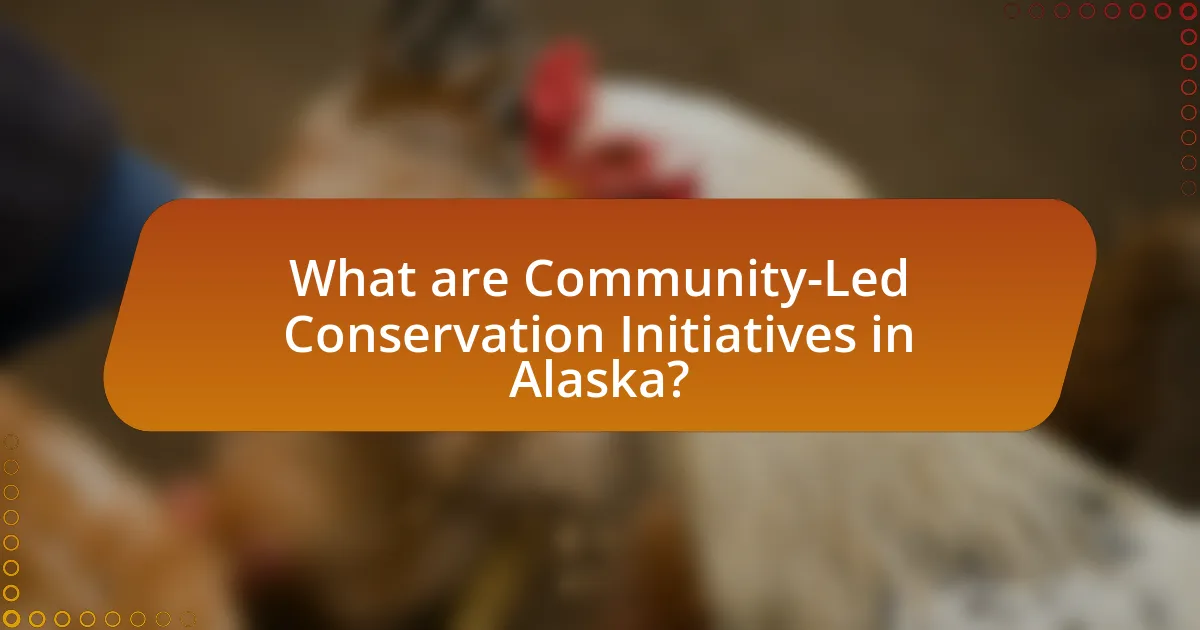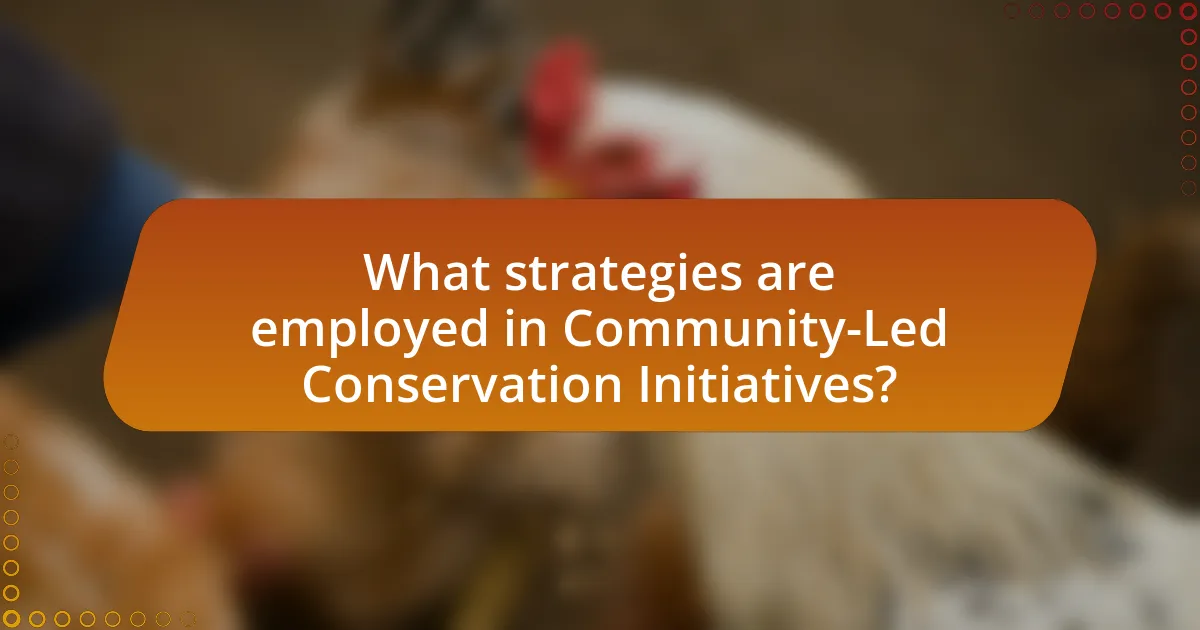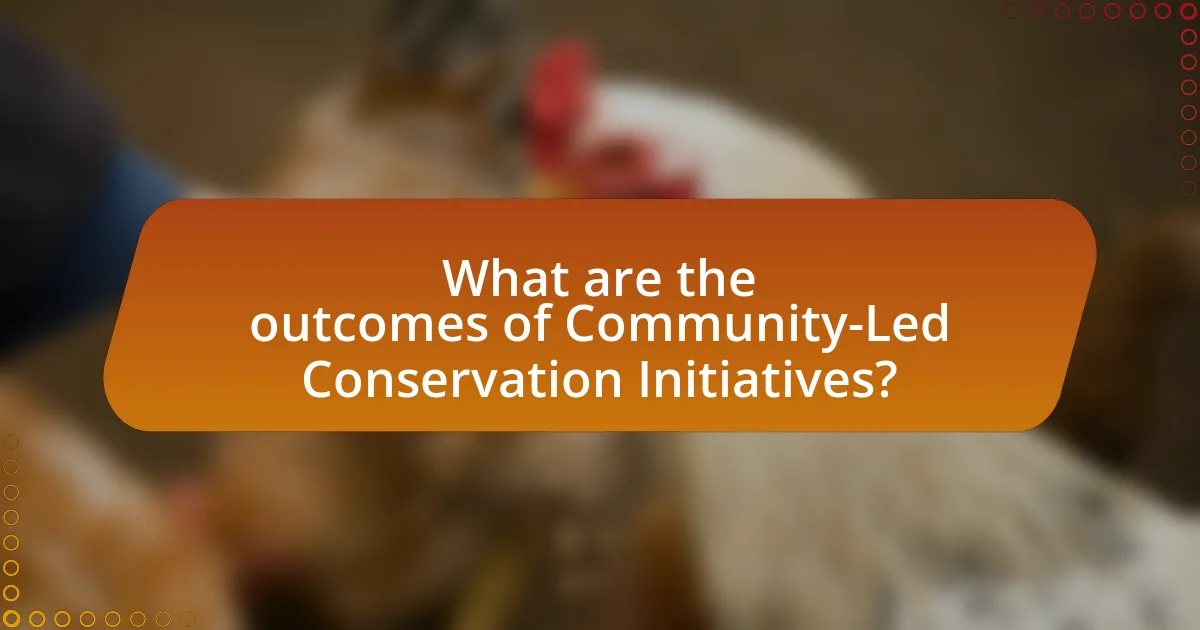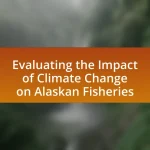Community-Led Conservation Initiatives in Alaska are collaborative efforts where local communities engage in managing and protecting their natural resources to combat environmental challenges, particularly climate change. These initiatives incorporate traditional ecological knowledge and involve partnerships with various stakeholders, including government agencies and non-profit organizations. They address specific climate challenges faced by Alaskan communities, such as permafrost thaw and changing wildlife patterns, by promoting sustainable land management practices that enhance ecosystem resilience. The article explores the strategies employed in these initiatives, the role of local knowledge, the partnerships formed, and the outcomes achieved, highlighting the importance of community involvement in effective conservation efforts.

What are Community-Led Conservation Initiatives in Alaska?
Community-Led Conservation Initiatives in Alaska are collaborative efforts where local communities actively engage in the management and protection of their natural resources to address environmental challenges, particularly those posed by climate change. These initiatives often involve traditional ecological knowledge, local governance, and partnerships with various stakeholders, including government agencies and non-profit organizations. For example, the Kachemak Bay Conservation Society has implemented community-driven projects that focus on habitat restoration and sustainable fisheries management, demonstrating the effectiveness of local involvement in conservation efforts.
How do these initiatives address climate change?
Community-led conservation initiatives in Alaska address climate change by promoting sustainable land management practices that enhance ecosystem resilience. These initiatives involve local communities in decision-making processes, ensuring that traditional ecological knowledge is integrated with scientific approaches. For example, the use of indigenous practices in resource management has been shown to improve biodiversity and mitigate the impacts of climate change, as evidenced by studies indicating that areas managed by local communities often exhibit greater ecological stability. Additionally, these initiatives facilitate habitat restoration and conservation efforts that directly reduce greenhouse gas emissions, contributing to climate change mitigation.
What specific climate challenges are faced by Alaskan communities?
Alaskan communities face specific climate challenges including permafrost thaw, increased coastal erosion, and changing wildlife patterns. Permafrost thaw disrupts infrastructure, leading to costly repairs and safety hazards, as observed in communities like Shishmaref, where homes are sinking. Increased coastal erosion threatens villages, with some, such as Newtok, facing relocation due to rising sea levels and storm surges. Additionally, changing wildlife patterns affect subsistence hunting and fishing, crucial for local diets and economies, as species migrate northward in response to warming temperatures. These challenges necessitate community-led conservation initiatives to adapt and mitigate impacts.
How do local knowledge and practices influence conservation efforts?
Local knowledge and practices significantly influence conservation efforts by providing insights into sustainable resource management and ecosystem dynamics. In Alaska, Indigenous communities utilize traditional ecological knowledge, which encompasses centuries of observations and practices that inform current conservation strategies. For instance, local hunters and fishers understand seasonal patterns and species behaviors, which can enhance the effectiveness of conservation measures. Research indicates that integrating local knowledge with scientific approaches leads to more adaptive and resilient conservation practices, as evidenced by successful community-led initiatives that have improved biodiversity outcomes and strengthened local stewardship.
Why are community-led initiatives important for conservation?
Community-led initiatives are crucial for conservation because they empower local populations to actively participate in the management and protection of their natural resources. These initiatives often lead to more effective conservation outcomes, as local communities possess intimate knowledge of their ecosystems and are directly affected by environmental changes. For instance, research has shown that community-based management can enhance biodiversity and improve ecosystem resilience, particularly in regions like Alaska, where indigenous practices have historically contributed to sustainable resource use. By involving communities in decision-making processes, these initiatives foster a sense of ownership and responsibility, which is essential for long-term conservation success.
What role do local communities play in environmental stewardship?
Local communities play a crucial role in environmental stewardship by actively engaging in conservation initiatives that address climate change impacts. These communities often possess traditional ecological knowledge, which informs sustainable practices and resource management. For instance, in Alaska, Indigenous groups have implemented community-led conservation projects that restore habitats and protect biodiversity, demonstrating their commitment to environmental stewardship. Research shows that local involvement in conservation efforts leads to more effective and culturally relevant outcomes, as seen in the collaborative management of natural resources in various Alaskan ecosystems.
How do these initiatives enhance biodiversity and ecosystem resilience?
Community-led conservation initiatives enhance biodiversity and ecosystem resilience by promoting local stewardship and adaptive management practices. These initiatives often involve the restoration of native habitats, which supports diverse species and strengthens ecological networks. For instance, in Alaska, community-led efforts to restore salmon habitats have been shown to increase fish populations, thereby benefiting the entire aquatic ecosystem. Additionally, these initiatives foster collaboration among local stakeholders, leading to more effective responses to climate change impacts, such as habitat loss and species migration. Research indicates that areas managed by local communities often exhibit higher levels of biodiversity compared to those managed solely by governmental entities, demonstrating the effectiveness of localized conservation strategies.

What strategies are employed in Community-Led Conservation Initiatives?
Community-Led Conservation Initiatives employ strategies such as participatory resource management, local knowledge integration, and capacity building. Participatory resource management involves engaging community members in decision-making processes regarding the use and conservation of local resources, ensuring that their needs and perspectives are prioritized. Local knowledge integration incorporates traditional ecological knowledge into conservation practices, enhancing the effectiveness of initiatives by aligning them with the community’s historical understanding of the environment. Capacity building focuses on empowering local communities through training and education, enabling them to implement and sustain conservation efforts independently. These strategies have been shown to improve biodiversity outcomes and enhance community resilience to climate change impacts in Alaska.
How do communities identify conservation priorities?
Communities identify conservation priorities through a collaborative process that involves local knowledge, ecological assessments, and stakeholder engagement. This process often includes gathering input from community members, scientists, and conservation organizations to evaluate the ecological significance of various areas and species. For instance, in Alaska, Indigenous knowledge plays a crucial role in identifying areas that are culturally significant and ecologically vulnerable, ensuring that conservation efforts align with both environmental and community needs. Studies have shown that integrating traditional ecological knowledge with scientific data leads to more effective conservation strategies, as evidenced by successful initiatives in various Alaskan communities that have prioritized habitat restoration and species protection based on local insights and ecological data.
What methods are used for community engagement and participation?
Community engagement and participation in conservation initiatives in Alaska utilize methods such as participatory mapping, community workshops, and collaborative decision-making processes. Participatory mapping allows community members to visually represent their knowledge of local resources and environmental changes, fostering a sense of ownership and involvement. Community workshops facilitate dialogue and knowledge sharing, enabling participants to express their concerns and ideas regarding climate change impacts. Collaborative decision-making processes ensure that community voices are integrated into planning and implementation, enhancing the effectiveness of conservation strategies. These methods have been shown to improve community resilience and adaptability in the face of climate change, as evidenced by successful projects that incorporate local knowledge and priorities.
How is traditional ecological knowledge integrated into these strategies?
Traditional ecological knowledge (TEK) is integrated into community-led conservation initiatives in Alaska by incorporating Indigenous practices and insights into environmental management strategies. This integration allows for a holistic understanding of local ecosystems, as TEK encompasses centuries of observations and adaptations to climate variability. For instance, Alaskan Native communities utilize TEK to inform decisions on resource management, such as sustainable hunting and fishing practices, which are crucial for maintaining biodiversity and resilience against climate change impacts. Studies have shown that combining TEK with scientific approaches enhances the effectiveness of conservation efforts, as it respects cultural values and promotes community engagement in environmental stewardship.
What partnerships are formed to support these initiatives?
Partnerships formed to support community-led conservation initiatives in response to climate change in Alaska include collaborations between local Indigenous groups, governmental agencies, non-profit organizations, and academic institutions. These partnerships leverage traditional ecological knowledge and scientific research to develop effective conservation strategies. For instance, the collaboration between the Alaska Native Tribal Health Consortium and various environmental organizations has facilitated projects aimed at enhancing community resilience to climate impacts, demonstrating the effectiveness of integrating local knowledge with scientific approaches.
How do collaborations with governmental and non-governmental organizations enhance efforts?
Collaborations with governmental and non-governmental organizations enhance efforts by pooling resources, expertise, and networks to address complex challenges like climate change. These partnerships enable the sharing of knowledge and best practices, which is crucial for developing effective conservation strategies. For instance, the Alaska Climate Change Adaptation Science Center collaborates with local communities and NGOs to implement tailored conservation initiatives that reflect local needs and conditions, thereby increasing the likelihood of successful outcomes. Such collaborations also facilitate access to funding and technical support, which are essential for sustaining long-term conservation efforts in the face of climate change.
What funding sources are available for community-led projects?
Funding sources available for community-led projects include government grants, private foundations, crowdfunding platforms, and corporate sponsorships. Government grants, such as those from the National Oceanic and Atmospheric Administration (NOAA) and the Environmental Protection Agency (EPA), specifically support initiatives addressing climate change impacts. Private foundations like the Ford Foundation and the Packard Foundation often provide funding for community-driven environmental projects. Crowdfunding platforms, such as GoFundMe and Kickstarter, allow communities to raise funds directly from individuals interested in supporting local initiatives. Additionally, corporate sponsorships from businesses committed to corporate social responsibility can provide financial support for these projects.

What are the outcomes of Community-Led Conservation Initiatives?
Community-Led Conservation Initiatives in Alaska result in enhanced biodiversity, improved local livelihoods, and increased community resilience to climate change. These initiatives empower local communities to manage natural resources sustainably, leading to the restoration of ecosystems and protection of wildlife habitats. For instance, a study by the Alaska Native Tribal Health Consortium found that community-led efforts in the Yukon-Kuskokwim Delta improved fish populations and strengthened traditional ecological knowledge, which is crucial for adapting to changing environmental conditions. Additionally, these initiatives foster collaboration among stakeholders, ensuring that conservation efforts align with local needs and cultural practices, ultimately contributing to long-term environmental sustainability.
How do these initiatives impact local ecosystems?
Community-led conservation initiatives in Alaska positively impact local ecosystems by enhancing biodiversity and promoting sustainable resource management. These initiatives often involve local communities in monitoring wildlife populations, restoring habitats, and implementing practices that reduce environmental degradation. For instance, the Kachemak Bay Conservation Society has engaged local residents in efforts to restore eelgrass beds, which are crucial for fish nurseries and overall marine health. Research indicates that such community involvement leads to improved ecological outcomes, as local knowledge and stewardship foster more effective conservation strategies.
What measurable changes have been observed in biodiversity?
Measurable changes observed in biodiversity include shifts in species distribution, alterations in species richness, and changes in ecosystem composition. For instance, research indicates that climate change has led to the northward migration of various species in Alaska, with some species, such as the Arctic fox, experiencing habitat loss due to warming temperatures. Additionally, studies have shown a decline in certain fish populations, which affects the overall biodiversity in aquatic ecosystems. These changes are documented in reports from the U.S. Fish and Wildlife Service, highlighting the impact of climate change on local flora and fauna.
How do these initiatives contribute to climate adaptation strategies?
Community-led conservation initiatives in Alaska contribute to climate adaptation strategies by enhancing local resilience and promoting sustainable practices. These initiatives empower communities to manage natural resources effectively, which helps mitigate the impacts of climate change, such as habitat loss and altered ecosystems. For instance, local knowledge and traditional practices are integrated into conservation efforts, leading to more effective responses to changing environmental conditions. Research indicates that community engagement in conservation not only fosters biodiversity but also strengthens social networks, which are crucial for collective action in adapting to climate challenges.
What social and economic benefits arise from these initiatives?
Community-led conservation initiatives in Alaska provide significant social and economic benefits, including enhanced community resilience and sustainable economic development. These initiatives foster social cohesion by engaging local populations in decision-making processes, which strengthens community bonds and promotes collective action. Economically, they create job opportunities in conservation, tourism, and sustainable resource management, contributing to local economies. For instance, a study by the Alaska Native Tribal Health Consortium found that community-led projects can lead to a 20% increase in local employment rates. Additionally, these initiatives help preserve traditional knowledge and practices, which can be economically beneficial through the promotion of cultural tourism.
How do community-led efforts improve local livelihoods?
Community-led efforts improve local livelihoods by fostering sustainable practices that enhance resource management and economic opportunities. For instance, in Alaska, Indigenous communities engage in conservation initiatives that protect local ecosystems while promoting traditional practices, such as fishing and hunting, which are vital for their economic stability. Research indicates that these community-led conservation strategies not only preserve biodiversity but also create jobs and support local businesses, thereby directly contributing to improved economic conditions. A study by the Alaska Native Tribal Health Consortium highlights that such initiatives can lead to increased food security and resilience against climate change impacts, further validating the positive correlation between community-led efforts and enhanced local livelihoods.
What role do these initiatives play in fostering community resilience?
Community-led conservation initiatives play a crucial role in fostering community resilience by empowering local populations to actively engage in environmental stewardship and resource management. These initiatives enhance adaptive capacity by integrating traditional ecological knowledge with modern conservation practices, thereby enabling communities to respond effectively to climate change impacts. For instance, in Alaska, such initiatives have been shown to improve food security and biodiversity, as evidenced by the collaborative efforts of Indigenous groups to restore salmon habitats, which directly supports local livelihoods and cultural practices. This synergy between community involvement and ecological health strengthens social networks and increases the overall resilience of communities facing climate-related challenges.
What challenges do Community-Led Conservation Initiatives face?
Community-Led Conservation Initiatives face several challenges, including limited funding, lack of technical expertise, and conflicts with external stakeholders. Limited funding restricts the ability to implement and sustain conservation projects, as many initiatives rely on grants or donations that may not be consistently available. Additionally, a lack of technical expertise can hinder the effectiveness of these initiatives, as community members may not possess the necessary skills or knowledge to address complex environmental issues. Conflicts with external stakeholders, such as government agencies or private companies, can also arise, leading to tensions that undermine collaborative efforts. These challenges are documented in various studies, including the report “Community-Based Conservation: A Review of the Evidence” by the World Wildlife Fund, which highlights the importance of addressing these barriers for successful conservation outcomes.
What barriers hinder the effectiveness of these initiatives?
Barriers that hinder the effectiveness of community-led conservation initiatives in response to climate change in Alaska include limited funding, lack of local engagement, and insufficient access to scientific data. Limited funding restricts the resources available for implementing and sustaining projects, which can lead to incomplete initiatives. Lack of local engagement often results in insufficient community buy-in, reducing the likelihood of successful outcomes. Additionally, insufficient access to scientific data can hinder informed decision-making, making it difficult for communities to develop effective strategies tailored to their specific environmental challenges. These barriers collectively undermine the potential impact of conservation efforts in the region.
How can communities overcome these challenges?
Communities can overcome challenges related to climate change by implementing collaborative conservation initiatives that engage local knowledge and resources. By fostering partnerships among residents, local organizations, and governmental agencies, communities can develop tailored strategies that address specific environmental issues. For instance, the Alaska Native Tribal Health Consortium has successfully integrated traditional ecological knowledge with scientific research to enhance resilience against climate impacts. This approach not only empowers local populations but also ensures that conservation efforts are culturally relevant and effective.
What best practices can be adopted for successful community-led conservation?
Successful community-led conservation can be achieved through inclusive stakeholder engagement, which ensures that local voices and knowledge are integral to decision-making processes. This practice fosters a sense of ownership and responsibility among community members, leading to more effective conservation outcomes. For instance, the Alaska Native Claims Settlement Act has empowered Indigenous communities to manage their lands, demonstrating that local governance can enhance conservation efforts. Additionally, integrating traditional ecological knowledge with scientific research can provide a comprehensive understanding of local ecosystems, further supporting conservation initiatives.
How can communities effectively measure the success of their initiatives?
Communities can effectively measure the success of their initiatives by establishing clear, quantifiable goals and utilizing specific metrics to assess progress. For instance, communities can track changes in biodiversity, water quality, or community engagement levels as indicators of initiative effectiveness. Research conducted by the Alaska Native Tribal Health Consortium highlights that communities implementing conservation initiatives have successfully used pre- and post-initiative surveys to gauge environmental and social impacts, demonstrating measurable improvements in local ecosystems and community well-being. This approach allows for data-driven evaluations that inform future strategies and enhance accountability.
What lessons can be learned from successful case studies in Alaska?
Successful case studies in Alaska demonstrate the importance of community engagement and local knowledge in conservation efforts. These initiatives, such as the Kachemak Bay Conservation Society’s work, highlight that involving local residents leads to more effective and sustainable environmental management. For instance, the community-driven approach in Kachemak Bay resulted in enhanced biodiversity and improved fishery management, showcasing that local stewardship can yield significant ecological benefits. Additionally, these case studies reveal that adaptive management strategies, which incorporate traditional ecological knowledge, are crucial for addressing the unique challenges posed by climate change in the region.


